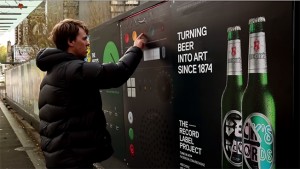“Print is just a broken touchscreen.”
This radical statement introduced the SXSW Interactive audience Tuesday to Kate Stone and Charlotte Brimner’s panel, Making Music Physical Again.
Stone, of UK technology company Novalia, explained that she works with bluetooth connectivity to build interactivity based around paper. By channeling touch, connectivity and data back into everyday physical objects many of these “declared dead” items can reclaim their value, she said.
“I think people in the future will have gotten over being futuristic. It’s like vacation destinations everyone dreams about… to the people who live there it’s just home.”
“I believe the future will look more like the past [but] our everyday objects will be portals to the Internet,” she continued, adding that her vision of the future looked more like real-life versions of Mary Poppins and Harry Potter than Minority Report.
“But maybe that’s just my dream,” she said laughing.
A dream that she is working hard to build. Stone and Novalia have worked on projects using conductive ink and electronics to create paper posters which would, when touched, play music and allow users to interact with the songs.
 An event that made use of this technology was Beck’s Beer‘s campaign to support up-and-coming New Zealand musicians. They created large street posters which walkers-by could touch and interact with. The posters played music from selected bands as well as allowed users to overlay different effects and drumbeats.
An event that made use of this technology was Beck’s Beer‘s campaign to support up-and-coming New Zealand musicians. They created large street posters which walkers-by could touch and interact with. The posters played music from selected bands as well as allowed users to overlay different effects and drumbeats.
Another project Stone worked on was a new album for celebrated DJ Qbert, which would be his first after a 15 year hiatus. The DJ wanted to release a vinyl album where a record sized card printed with turntables that actually worked would be included.
Stone not only was able to build these paper turntables, she demonstrated the connected card stock for the panel.
Charlotte Brimner, a 17 year old Scottish self-produced musician made up the other half of this engaging and entertaining panel.
She shared her experienes working with Stone to create innovative experiences in digital music, not only for her performances but also for her fans’ engagement.
One was the idea of creating a connected book, again using regular paper and binding techniques, that through bluetooth connectivity was able to play Brimner’s music. Beyond this functionality, the book would have a page dedicated to upcoming work and albums. As Brimner wrote lyrics or new melodies, she could push that information to the page in her fan’s books, and they could up-vote or comment on them.
They also built a notebook with piano keys on the cover which play, a hairbrush with graphic decals on the back that play different notes and a bracelet whose gems can be pressed to play midi sounds.
Brimner demonstrated some of these objects during a short performance for the object.
An audience member shared a thought that Stone heartily agreed with: new technology isn’t always and “either/or” but is often an “and.” Stone continued, saying that her belief is that new technology can actually help revive older, ordinary objects. Her hope is to use new connectivity and digital innovation to reconnect us to our environment.
She shared moments from her childhood when communities felt connected and knew what each other were doing or experiencing.
“I don’t feel like we’re going to some scary future. I feel like we’re going home,” she said to resounding applause.
